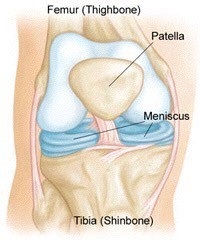Meniscal tears, also referred to as torn cartilage, are among the most common knee injuries. Athletes, particularly those who play contact sports, are at risk for meniscal tears, as well as people who have jobs that require lots of squatting. Although meniscal tears are common in those who play contact sports, anyone at any age can tear a meniscus. The meniscus is a rubbery, C-shaped piece of cartilage that cushions your knee. Each of your knees has 2 menisci, one on the inner (medial) part of the knee, and the other on the outer (lateral) part. Together they act to absorb shock and stabilize the knee joint. Menisci tear in different ways. Tears are noted by how they look, as well as where the tear occurs in the meniscus. Common tears include longitudinal, parrot-beak, flap, bucket handle, and mixed/complex. Sports- related meniscal tears often occur along with other knee injuries, such as anterior cruciate ligament tears. A meniscal tear typically is caused by twisting or turning quickly on a bent knee, often with the foot planted on the ground.
Your doctor may diagnose a torn meniscus, but meniscal injuries can often be managed without surgery. A short course of treatment provided by a physical therapist can help determine whether your knee will recover without surgery. The physical therapist plays an important role by controlling pain and swelling and by restoring full strength and mobility to your knee.

